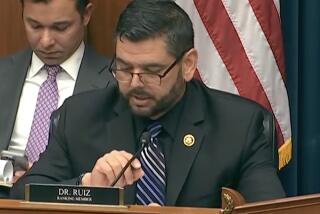Data Held Too Incomplete for Study of Agent Orange
WASHINGTON — A White House science panel has concluded that incomplete military records may make it impossible to perform a scientifically acceptable study ordered by Congress on the relationship between health problems and exposure to the herbicide Agent Orange during the Vietnam War.
As a result, tens of thousands of veterans and their families might never know with scientific certainty whether a wide range of ailments were caused by wartime contact with the chemical defoliant. In addition, the failure to complete the study would leave in question the safety of using the herbicide--now banned by a presidential order--in future wars.
The report by the panel also contains an allegation by the former top U.S. military official in South Vietnam that the Justice Department is “stonewalling” attempts by Vietnam veterans to get military documents to help substantiate court claims that they were harmfully exposed to Agent Orange.
The Justice Department denied the charge and said it has been cooperating with lawyers representing veterans.
The entire 364-page document, a copy of which was made available to The Times, represents an effort by the Reagan Administration to respond to a 1980 congressional mandate to assess the possible health effects of Agent Orange, which contains small amounts of dioxin, a particularly toxic poison. The Administration now appears to be on the verge of telling Congress it cannot complete the study.
“We’re not saying people weren’t exposed or that they don’t have problems,” said a scientist who worked on the report. “We’re saying you can’t do a scientifically valid study based on military records.”
While this was designed to be the most comprehensive study of the health effects of Agent Orange, other studies are tracking Air Force veterans who worked with the herbicide, examining the physical and psychological effects of service in Vietnam, tracking women who served in Vietnam and examining the development of certain kinds of cancer among veterans. So far those studies have found little or no correlation between health problems and Agent Orange exposure in Vietnam.
A copy of the science panel’s report also has been sent to the House Veterans Affairs subcommittee on hospitals and health care, which will turn it over to the congressional Office of Technology Assessment for review.
“There is unanimous agreement that an epidemiological study of ground troops’ possible exposures to Agent Orange, . . . based solely on military records, does not appear to be scientifically feasible,” the White House’s Agent Orange Working Group’s science panel concluded.
‘Battlefield No Laboratory’
One official who helped prepare the report said: “The records do not support using the Vietnam battlefield as a scientific laboratory.”
The records fail to show soldiers’ daily locations or document all the aerial and ground spraying that was done to defoliate jungles and kill crops where the enemy was operating.
Before officially throwing in the towel, the White House panel is awaiting a report from the Centers for Disease Control, which is testing a method to detect dioxin exposure in blood serum.
But if that method cannot be combined with available military records to show which veterans were exposed to the herbicide, “the Agent Orange epidemiological study should be discontinued,” the report says.
Former Defense Attache
The allegations that the Justice Department is hampering efforts by Vietnam veterans to settle Agent Orange damage claims in court are contained in a 100-page section authored by retired Maj. Gen. John E. Murray, who was the U.S. defense attache to South Vietnam in 1973 and 1974 and head of a then-secret Pentagon command aiding the South Vietnamese army.
In early 1985, seven manufacturers of Agent Orange settled a massive class action lawsuit by Vietnam veterans and their families who contended they were harmed by the chemical. The agreement created a $215-million fund to pay about 250,000 pending claims. The soldiers cited a wide range of ailments, including nerve defects, skin conditions, defects in offspring and cancer.
Murray writes that the Joint Services Environmental Support Group, a Pentagon agency, has both documents and experts who could help settle the claims but that “the Department of Justice has prohibited this help to the veterans and is in effect taking money out of their pockets.”
Would Locate Units
The documents, though not sufficiently comprehensive for the scientific study, would show where some soldiers’ units were operating at the time Agent Orange was being sprayed.
“The Justice Department . . . has declared the United States will not help veterans to obtain their maximum entitlements on a best evidence basis,” Murray says. “This is apparent stonewalling.” Murray says he met with Justice Department officials as recently as May 22 and they refused to change their position.
Richard K. Willard, assistant attorney general in charge of the civil division, replied that “we agreed to make available a very large amount of documentary material,” including 16 boxes of documents and tapes. “What we would not do is participate in the structure and dispersal of the settlement. We don’t want to be involved in making value judgments about who gets what part of the settlement money.”
‘Ongoing Litigation’
Willard said the department also has refused to allow lawyers in the class action suit “free-ranging access to government employees.” The case is pending in a federal appeals court, and Willard said, “because this is ongoing litigation, these employees might be witnesses in future proceedings.”
The section of the report authored by Murray also contains the proposal that the government stop spending millions trying to determine the harm done to veterans by Agent Orange and, instead, make compensatory payments to veterans who may have been exposed.
The United States commonly compensated the Vietnamese for accidental wartime damage, Murray writes. “If we practice this for alien people, why not our own?”
More to Read
Sign up for Essential California
The most important California stories and recommendations in your inbox every morning.
You may occasionally receive promotional content from the Los Angeles Times.










